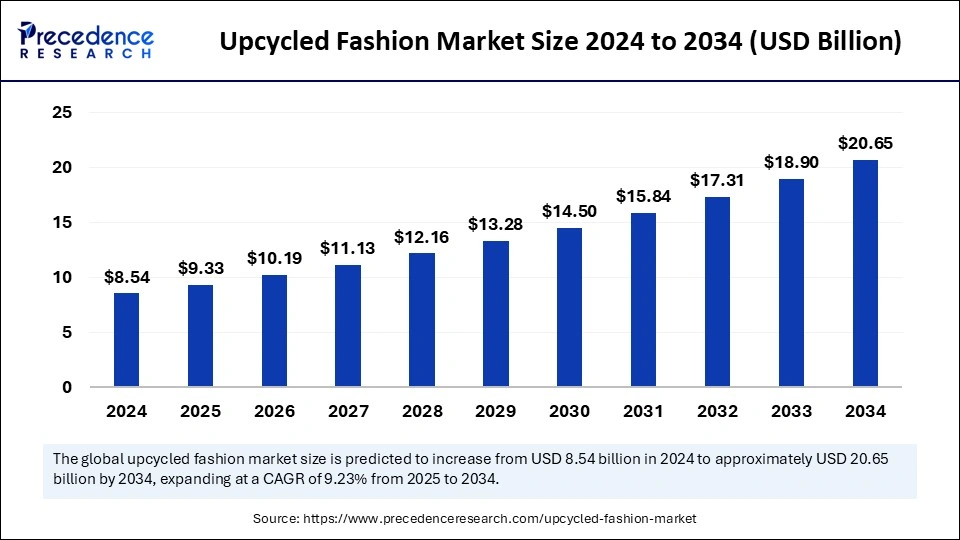Upcycled fashion market is projected to grow from USD 8.54 billion in 2024 to USD 20.65 billion by 2034, with a CAGR of 9.23%.

Upcycled Fashion Market Key Takeaways
- Europe led the market with the largest share of 36% in 2024.
- Asia Pacific is expected to expand at the highest CAGR between 2025 and 2034.
- By type, the apparel segment held the biggest market share of 69% in 2024.
- By type, the accessories segment is anticipated to witness the fastest growth during the forecast period.
- By end-use, the women segment captured the largest market share in 2024.
- By end-use, the men segment is expected to expand at the highest CAGR over the projection period.
- By distribution channel, the offline segment dominated the market in 2024.
- By distribution channel, the online is expected to be the fastest-growing segment in the coming years.
Upcycled Fashion Market Overview
The global upcycled fashion market is witnessing robust growth as consumers and brands increasingly prioritize sustainability and circular fashion practices. Upcycled fashion refers to the process of transforming used, discarded, or waste materials into new, high-quality fashion products. This innovative approach reduces textile waste, minimizes environmental impact, and extends the life cycle of fashion products. Driven by heightened consumer awareness of environmental issues and a growing emphasis on sustainable consumption, upcycled fashion has gained traction among eco-conscious shoppers.
Major fashion brands, independent designers, and emerging startups are embracing upcycling to differentiate their offerings, reduce carbon footprints, and cater to evolving consumer preferences. Additionally, the incorporation of advanced technologies such as artificial intelligence (AI) and blockchain in tracking and authenticating upcycled products is enhancing transparency and credibility. As governments implement stringent regulations to reduce textile waste and promote sustainable practices, the upcycled fashion market is poised for sustained growth. The growing popularity of ethical fashion, combined with innovative design techniques and creative approaches to repurposing materials, is shaping the future of the global fashion industry.
Upcycled Fashion Market Drivers
-
Increasing Consumer Demand for Sustainable Fashion: Eco-conscious consumers are actively seeking fashion alternatives that align with their environmental and ethical values, driving the demand for upcycled products.
-
Rising Concerns Over Textile Waste and Environmental Impact: The fashion industry’s contribution to global waste and pollution has prompted brands to adopt sustainable solutions such as upcycling to mitigate environmental harm.
-
Government Regulations and Circular Economy Initiatives: Regulatory bodies worldwide are encouraging the adoption of circular economy models by promoting waste reduction and sustainable fashion practices.
-
Innovations in Textile Recycling and Repurposing Technologies: Technological advancements in fabric recycling and material repurposing are enhancing the efficiency and scalability of upcycling processes.
Upcycled Fashion Market Opportunities
-
Collaboration with Luxury Brands and Fashion Designers: Collaborating with high-end designers and established brands can help upcycled fashion brands gain credibility and expand their market reach.
-
Integration of AI and Blockchain for Transparency and Authentication: The use of AI-powered analytics and blockchain technology can improve traceability and build consumer trust in the authenticity of upcycled fashion.
-
Expansion of Circular Fashion Subscription Models: Subscription-based models offering curated upcycled fashion items present an opportunity to create a loyal customer base while promoting sustainable consumption.
-
Growth of E-Commerce Platforms for Sustainable Fashion: The increasing popularity of online platforms focused on eco-friendly and upcycled products offers a significant growth avenue for market players.
Upcycled Fashion Market Challenges
-
High Production Costs and Limited Scalability: The cost of sourcing, cleaning, and repurposing discarded materials can be higher than producing conventional fashion items, posing challenges for scalability.
-
Consumer Skepticism About Quality and Durability: Some consumers may be hesitant to adopt upcycled fashion due to concerns about product quality and durability, requiring education and awareness.
-
Inconsistent Supply of Raw Materials: Ensuring a consistent and reliable supply of discarded fabrics and materials for upcycling can be challenging, affecting production efficiency.
-
Regulatory Compliance and Certification Challenges: Meeting industry standards and obtaining certifications for upcycled products can be complex and time-consuming for market entrants.
Upcycled Fashion Market Regional Insights
-
North America: Leads the market due to strong consumer awareness, growing demand for sustainable fashion, and government initiatives promoting circular economy practices.
-
Europe: Witnesses steady growth driven by stringent environmental regulations, high adoption of sustainable practices, and a strong presence of eco-conscious consumers.
-
Asia Pacific: Anticipated to experience rapid growth due to increasing urbanization, rising disposable income, and growing awareness of sustainable fashion in emerging economies.
Upcycled Fashion Market Recent Developments
-
Launch of innovative upcycled fashion collections by leading brands and designers.
-
Introduction of AI-powered platforms to enhance transparency and traceability in the upcycled fashion supply chain.
-
Expansion of circular fashion initiatives through strategic collaborations and partnerships.
-
Implementation of government policies to promote sustainable fashion practices and reduce textile waste.
Upcycled Fashion Market Companies
- Ferrangamo
- La Bouche Rouge
- Hublot
- Rothy’s
- Todd Snyder
- Lumene
- Patagonia
- Eileen Fisher
- Beyond Retro
- TOAST
Segments Covered in the Report
By Type
- Apparel
- Accessories
- Footwear
- Others
By End-Use
- Women
- Men
- Unisex
- Others (Kids)
By Distribution Channel
- Offline
- Online
By Geography
- North America
- Europe
- Asia Pacific
- Latin America
- Middle East and Africa
Ready for more? Dive into the full experience on our website!